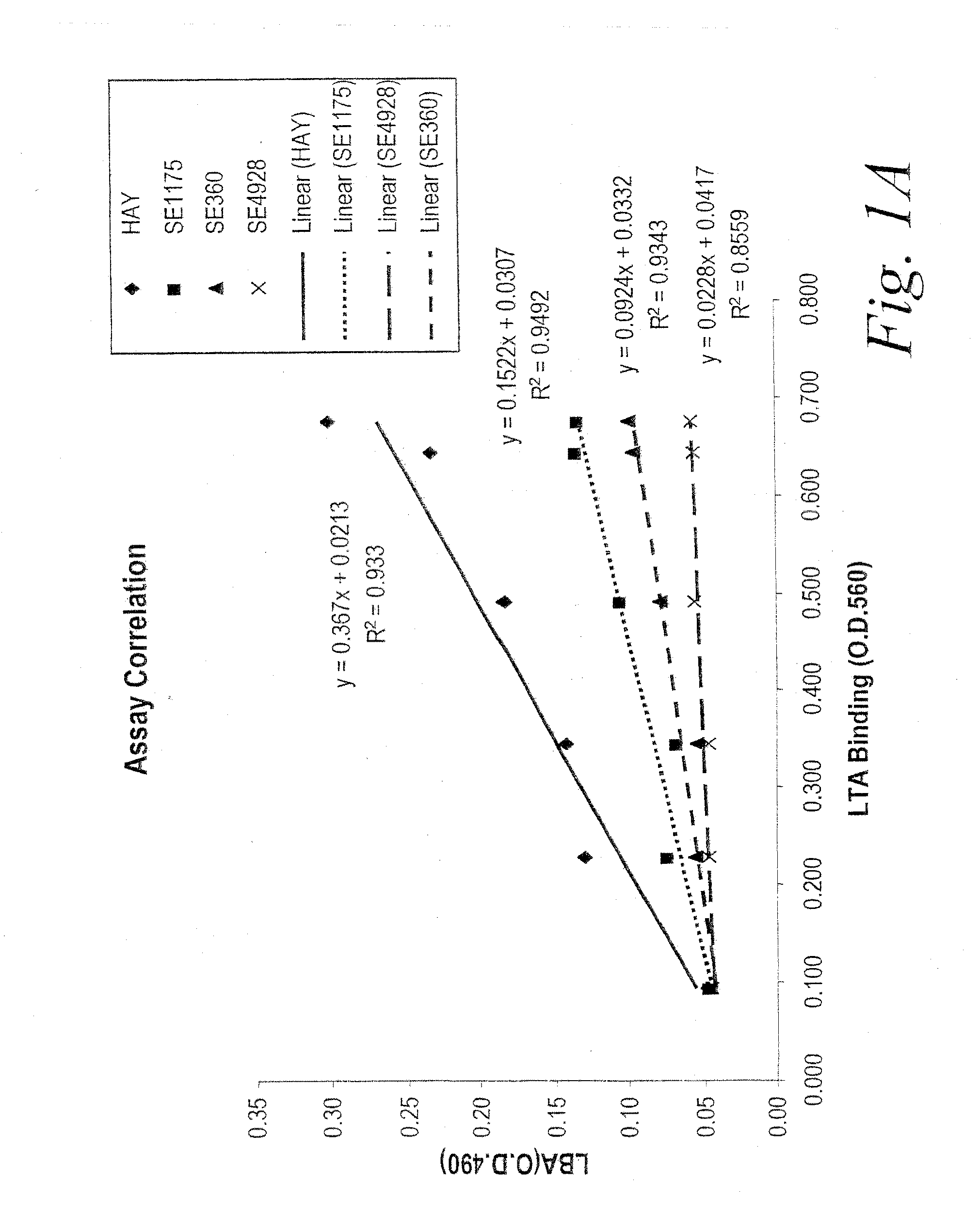Opsonic and protective antibodies specific for lipoteichoic acid of gram positive bacteria
a technology which is applied in the field of opsonic and protective antibodies specific for lipoteichoic acid of gram positive bacteria, can solve the problems of posing a threat to effective antimicrobial therapy, infection frequently occurring, and major morbidity and mortality of hospital acquired (nosocomial) infections, and achieve the effect of preventing a staphylococcal infection
- Summary
- Abstract
- Description
- Claims
- Application Information
AI Technical Summary
Problems solved by technology
Method used
Image
Examples
example 1
Construction of Variants
[0256]A number of variants derived from the parent A110 chimeric antibody, an anti-lipoteichoic acid (LTA) antibody, were generated by Applied Molecular Evolution (San Diego, Calif.) using their codon based mutagenesis and antibody engineering technology as described in Huse et al. (Huse et al., (1993) Intern. Rev. Immunol. 10:129-137, the entire contents of which are incorporated herein by reference) and Wu et al. (Wu et al., (1998) PNAS 95:6037-42, the entire contents of which are incorporated herein by reference). The nucleic acid sequences encoding the A110 CDRs and framework regions comprising the light and heavy chains are shown in SEQ ID NOs: 33 and 34, respectively. The six A110 CDRs employed are as follows: CDRL1 (SEQ ID NO:3); CDRL2 (SEQ ID NO: 4); CDRL3 (SEQ ID NO:5); CDRH1 (SEQ ID NO:6); CDRH2 (SEQ ID NO:7); and CDRH3 (SEQ ID NO8).
SEQ ID NO: 3RASSSVNYMHSEQ ID NO: 4ATSNLASSEQ ID NO: 5QQWSSNPPTSEQ ID NO: 6GFTFNNYAMNSEQ ID NO: 7RIRSKSNNYATFYADSVKDSEQ...
example 2
Screening of CDR Libraries
[0262]CDR mutant libraries were initially screened by capture lift to identify the highest affinity variants for binding to biotinylated lipoteichoic acid (Biotin-LTA). The Biotin-LTA was prepared freshly using Biotin LC hydrazide (Pierce Cat #21340), which is stable for up to two weeks if stored at 4° C. The capture lift procedure was performed as described previously (see, e.g., Huse et al. (1992) J. Immunol. 149:3914-3920; Watkins et al. (1997) Anal. Biochem. 253:37-45; Watkins et al. (2002) Methods Mol. Biol. 178:187-93; WO / 0164751; and US2002 / 0098189, the entire contents of each of which are incorporated herein by reference).
[0263]Subsequently, desired clones were characterized for antigen binding by single-point ELISA (SPE) (see, e.g., Watkins et al., supra, 1997) and titration of Fab proteins on immobilized LTA in an ELISA format. Following such screening, clones of interest were sequenced and mutations that enhance antigen-binding activity were iden...
example 3
Characterization of HCDR3 Beneficial Variants
[0266]Characterizations were carried out for all unique CDR mutants. The following example details characterization of the HCDR3 variants. However, this method was used to characterize all six CDRs.
[0267]Nine HCDR3 mutants (A1, B6, B7, C10, D3, G10, 1D3, 4B2 and 5A11), were characterized by Fab titration for binding to biotinylated-LTA (b-LTA). FIG. 2 depicts the results of an LTA binding assay of the HCDR3 beneficial variants in anti-Fab capture format. The LTA binding assay was performed essentially as previously described. Briefly, individual Fab fragments were produced in E. coli and periplasmic extracts were tested in ELISA for binding to biotinylated LTA (b-LTA). In order to identify LTA-binding Fab fragments, Fab fragments were captured from periplasmic extracts to an ELISA plate using an anti-Fab antibody, biotinylated-LTA (b-LTA) added and detected with NeutrAvidin™ (Pierce) conjugated to alkaline phosphatase (NeutrAvidin™-AP). A...
PUM
 Login to View More
Login to View More Abstract
Description
Claims
Application Information
 Login to View More
Login to View More - R&D
- Intellectual Property
- Life Sciences
- Materials
- Tech Scout
- Unparalleled Data Quality
- Higher Quality Content
- 60% Fewer Hallucinations
Browse by: Latest US Patents, China's latest patents, Technical Efficacy Thesaurus, Application Domain, Technology Topic, Popular Technical Reports.
© 2025 PatSnap. All rights reserved.Legal|Privacy policy|Modern Slavery Act Transparency Statement|Sitemap|About US| Contact US: help@patsnap.com



